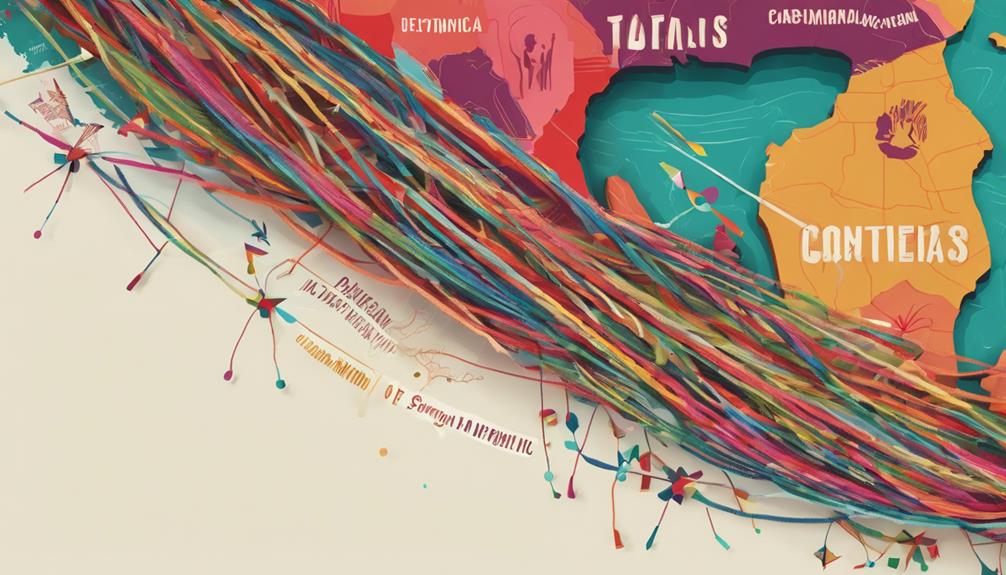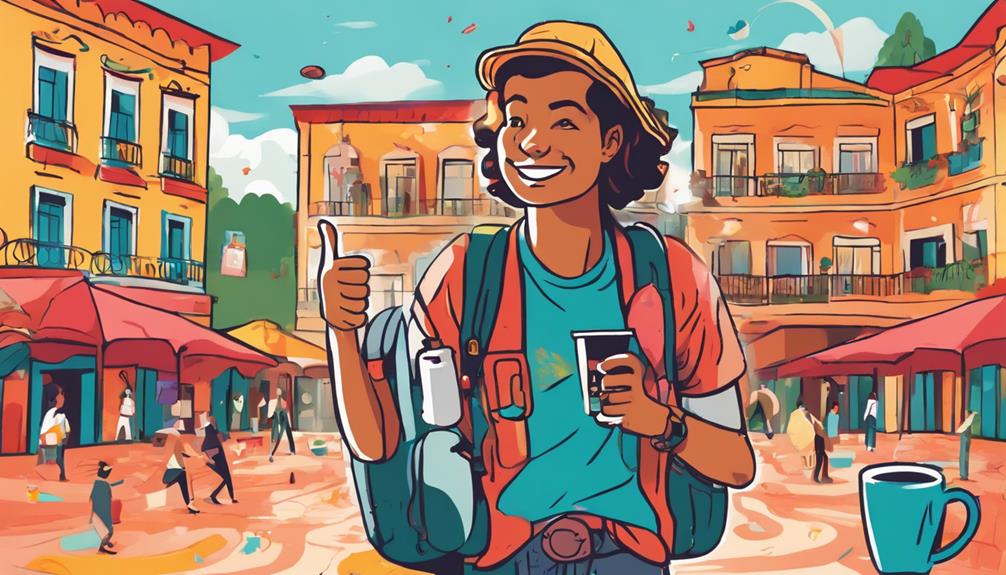You'll frequently hear 'no pasa nada' in Spanish conversations, which translates to 'it's all good,' but mastering this phrase is just the tip of the iceberg in a world where slang can make or break your cultural immersion. In Argentina, you'll use 'boludo' and 'pelotudo' in playful banter, while in Spain, familiarity with phrases like 'hasta luego' will help you build rapport with locals. As you explore Latin America, you'll discover unique slang variations like lunfardo in Argentina and Fronterizo dialect in Mexico. As you venture deeper into the world of Spanish slang, you'll uncover the rhythms and nuances that will elevate your interactions.
No Pasa Nada: The Ultimate Chill

When you find yourself in a sticky situation, 'no pasa nada' is the Spanish phrase that embodies the ultimate chill, conveying a carefree attitude that translates to 'it's nothing' or 'no big deal.'
This phrase is more than just a phrase – it's a mindset. It's a reminder that, in the grand scheme of things, most problems are insignificant.
When you adopt the 'no pasa nada' attitude, you're choosing to approach life's obstacles with a relaxation mindset. You're acknowledging that, yes, things might be tough, but they're not the end of the world.
This carefree attitude allows you to take a step back, breathe, and reassess the situation. It's about prioritizing what's truly important and letting go of the rest.
By incorporating 'no pasa nada' into your daily vocabulary, you'll find yourself better equipped to handle life's challenges with ease and poise.
Slang Expressions for Every Situation
You'll find that Spanish slang is packed with expressions that can be deployed in various situations, from casual hangouts to heated arguments, and mastering these phrases can help you navigate everyday conversations with ease. By understanding the nuances of Spanish slang, you'll be better equipped to communicate effectively in different social contexts.
Here are some essential expressions to get you started:
| Slang Expression | Situation |
|---|---|
| ¡Hagámoslo! | Encouragement to take action |
| ¡No drama! | Downplaying a situation |
| ¡Vale, vale! | Agreement or confirmation |
Mastering these slang expressions will help you tap into the cultural codes that underpin everyday conversations in Spanish-speaking countries. By incorporating these phrases into your vocabulary, you'll be able to convey subtle shades of meaning and build stronger relationships with native speakers. Remember, slang nuances can vary greatly across regions, so it's essential to stay attuned to local expressions to avoid cultural faux pas.
Argentina's Favorite Insults and Comebacks

By peppering your conversations with Argentina's favorite insults and comebacks, you'll be able to navigate the country's vibrant cultural landscape with confidence. In Buenos Aires, banter is an art form, and mastering the local lingo will earn you respect and admiration from the porteños. Insult artistry is a hallmark of Argentine culture, and being able to dish out clever comebacks is a badge of honor.
You'll want to learn phrases like 'boludo' (a term of endearment with a hint of mockery) and 'pelotudo' (a playful insult implying someone is lazy). When someone calls you 'gordo' (fatso), you can shoot back with 'flaco' (skinny).
In Argentina, the goal is to outwit and out-insult your opponent, all while maintaining a playful tone. Remember, the key to mastering Buenos Aires banter is to keep it light-hearted and humorous. With practice, you'll be trading clever insults like a native in no time.
Spain's Most Useful Slang Phrases
Mastering Spain's colloquial language requires familiarity with phrases like 'hasta luego' (see you later) and '¿quién onda?' (what's up?), which will help you navigate everyday conversations with locals.
You'll find that regional dialects have shaped the evolution of slang in Spain, with distinct phrases emerging in different regions. For instance, in the north, you might hear '¡hombre!' (man!) to express excitement or surprise, while in the south, ' ¡chollo!' (cool!) is used to express admiration.
When communicating with Spaniards, using colloquial language will help you build rapport and avoid coming across as a tourist. Phrases like '¿cómo va?' (how's it going?) and '¿qué pasa?' (what's up?) will help you initiate and maintain conversations. Additionally, understanding regional nuances will allow you to adapt your language to your surroundings.
As you explore Spain's slang, you'll notice how regional dialects have contributed to the rich tapestry of Spanish language, making it a fascinating and dynamic aspect of the culture. By incorporating these phrases into your vocabulary, you'll be well on your way to speaking like a native Spaniard.
Latin American Slang Across Borders

As you venture beyond Spain's borders, Latin American slang takes on a life of its own, with distinct dialects and idioms emerging in countries like Argentina, Mexico, and Colombia.
You'll notice that border dialects blend indigenous, African, and European influences, resulting in a rich cultural fusion. For instance, in Argentina, lunfardo, a slang born from Italian and Spanish immigrants, adds a unique flavor to everyday conversations.
In Mexico, the northern border region's proximity to the US has given rise to a distinct dialect, known as 'fronterizo,' which combines Mexican Spanish with American English.
Similarly, Colombia's coastal regions have developed a creole-like dialect, influenced by African and indigenous languages.
As you explore these border dialects, you'll discover a fascinating mosaic of cultural exchange, where languages blend and adapt to create new, vibrant forms of expression.
Everyday Expressions for Every Emotion
From annoyed to ecstatic, you'll find that Latin American slang has an expression to match every emotional nuance, allowing you to convey your feelings with precision and flair.
When faced with fear responses, you can express your anxiety with phrases like 'me da cosa' (it gives me the creeps) or 'me entra miedo' (I get scared).
On the other hand, joyful outbursts are easily conveyed with '¡Estoy flipando!' (I'm freaking out!) or '¡Estoy emocionado!' (I'm excited).
Cultural norms also influence the way you express empathy, with phrases like '¿Cómo estás, pana?' (How are you, buddy?) or '¿Qué onda, primo?' (What's up, cousin).
Empathy phrases like '¡Hagámoslo!' (Let's do it!) or '¡Vamos a hacerlo!' (Let's make it happen!) can serve as mood boosters.
In sentiment analysis, tone indicators like '¡No way, José!' (No way, José!) or '¡Eso es una locura!' (That's crazy!) help convey the emotional tone of your message.
Witty One-Liners for Any Occasion

When you need to add a dash of humor or irony to a conversation, Latin American slang has a witty one-liner to fit any situation, and you'll find yourself effortlessly tossing off phrases like 'No manches' (No way!) or 'Estoy al loro' (I'm on it!).
These phrases are perfect for adding a touch of humor to your conversations, and they can help you navigate everyday situations with ease. Whether you're looking for a sarcastic comeback or a humorous icebreaker, Latin American slang has got you covered.
For instance, you can use 'Eso es la vida' (That's life) to respond to a friend's complaint, or 'No hay bronca' (No worries) to diffuse a tense situation. You can even use 'Qué onda' (What's up) to initiate a conversation or 'Hasta la vista' (See you later) to bid farewell.
With these witty one-liners, you'll be well-equipped to handle any social situation that comes your way.
The Art of Slang in Latin Music
You'll often find that Latin music, particularly genres like reggaeton and Latin trap, rely heavily on slang to convey a sense of authenticity and cultural relevance. These genres have given birth to unique styles, such as the Reggaeton Flow, which is characterized by its fast-paced rhythm and clever wordplay. Artists use slang to speak directly to their audience, creating a sense of community and shared experience.
| Artist | Genre | Slang Term |
|---|---|---|
| J Balvin | Reggaeton | "Perra" (girl) |
| Bad Bunny | Latin Trap | "Diles" (tell them) |
| Rosalía | Flamenco Fusion | "Guapo" (handsome) |
| Maluma | Reggaeton | "Parcero" (buddy) |
| Daddy Yankee | Reggaeton | "Flow" (rhythm) |
When analyzing Latin music, it's essential to understand the slang used in each genre. Latin Beats, for example, often incorporate slang terms to create a sense of swag and confidence. By using slang, artists can convey complex emotions and ideas in a way that resonates with their audience. As you delve deeper into Latin music, you'll discover that slang is an integral part of the culture, and understanding it will enhance your appreciation for the music.
Slang for Travelers: Essential Phrases

As you navigate the vibrant streets of Spanish-speaking countries, mastering essential slang phrases will help you connect with locals and elevate your travel experience.
To avoid falling into tourist traps, it's important to learn phrases that will facilitate cultural immersion and conversational flow. Airport hacks, such as knowing the phrase '¿Dónde está la salida?' (Where is the exit?), can save you time and frustration.
To overcome language barriers, learn essential travel tips like '¿Cuánto cuesta?' (How much does it cost?) and '¿Dónde está…?' (Where is…?). This will enable you to navigate local markets and interact with vendors confidently.
Understanding cultural nuances, such as the difference between '¿Cómo estás?' (How are you?) and '¿Qué onda?' (What's up?), will help you build local insights and connections.
Embracing the Rhythm of Spanish Slang
By immersing yourself in the world of Spanish slang, you'll begin to appreciate the rhythmic cadence that underlies everyday interactions. Slang evolution is an integral part of this process, as new expressions emerge and old ones fade away, reflecting the dynamic nature of cultural identity.
To truly embody the rhythm of Spanish slang, you need to understand the cultural context in which it's used. This means being aware of the nuances of cultural identity and how they shape the language.
For instance, in some Latin American countries, slang is often used to assert regional pride and differentiate oneself from other cultural groups. By embracing this cultural complexity, you'll be better equipped to navigate the intricacies of Spanish slang and communicate more effectively with native speakers.
As you master the rhythms of Spanish slang, you'll find that your interactions become more authentic, and your connections with locals more meaningful.
Frequently Asked Questions
Can I Use Spanish Slang in Formal Writing or Professional Settings?
When considering using Spanish slang in formal writing or professional settings, you should exercise caution. While incorporating cultural authenticity can enrich your message, maintaining a professional tone is crucial.
Avoid using colloquial expressions that may come across as informal or unprofessional. Instead, opt for standard Spanish vocabulary that conveys your message effectively without compromising your credibility.
Are There Regional Differences in Spanish Slang Across Latin America?
You're about to set off on a linguistic adventure across Latin America, where a million nuances await!
When exploring regional differences in Spanish slang, you'll discover that each country, and even region, has its unique flavor. Latin American dialects are shaped by local history, cultural heritage, and geography, which shape distinct regional identities.
As you dig deeper, you'll find that Argentine Lunfardo differs greatly from Mexican Chamaco, and Colombian Paisa has its own rhythm.
Get ready to unravel the rich tapestry of Latin American slang!
How Do I Pronounce Spanish Slang Words Correctly?
When tackling Spanish slang, you'll quickly realize that Accents Matter. To pronounce words correctly, you must adopt the regional intonation and rhythm. Focus on the syllable stress, vowel sounds, and diphthongs.
Practice with native speakers or online resources to develop your ear. Slang Mastery requires precision, so pay attention to subtle variations in pronunciation. With consistent practice, you'll master the nuances of Spanish slang and sound like a native.
Can I Create My Own Spanish Slang Expressions?
You're a linguistic architect, building bridges between languages! Can you create your own Spanish slang expressions? Absolutely! Slang evolution is a natural process, and you can contribute to it.
Cultural fusion is where it's at – blend your cultural background with Spanish, and you'll craft unique expressions. Analyze the grammar, phonetics, and cultural nuances of Spanish slang, then inject your own flavor.
Are Spanish Slang Expressions Often Used in Formal Education?
When you step into a formal education setting, you'll rarely hear Spanish slang expressions being used in the classroom. The formal curriculum is typically filled with academic jargon, not colloquialisms. You'll find that instructors tend to stick to standardized language to maintain a level of professionalism.
While slang might be useful in casual conversations, it's not commonly incorporated into academic discourse. You'll need to adapt to formal language to succeed in these environments.
Conclusion
You've now got the keys to access the vibrant world of Spanish slang. As you navigate the twists and turns of everyday conversations, remember that slang is the secret ingredient that adds flavor to your interactions.
It's the rhythm that makes you move in sync with the locals, the spark that ignites meaningful connections, and the flair that makes your language skills truly unforgettable.
So, go ahead, immerse yourself in the rich tapestry of Spanish slang and let the fiesta begin!







